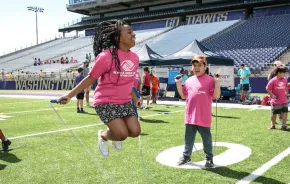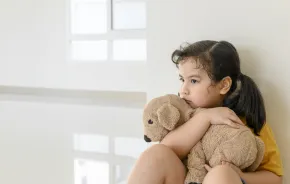
Editor's note: This article was sponsored by Seattle Children's Hospital.
Back-to-school season typically ushers in the welcome return of a predictable routine. This year, the only thing that’s certain is a whole lot of uncertainty. With most local schools resuming remote learning with a wait-and-see approach for the rest of the year, children and families are in limbo, with unanswered questions about safety, technology access, equity, health, child care and a host of other concerns. All of this adds up to a season that feels scary instead of secure, says pediatrician Mollie Grow, M.D., MPH, of Seattle Children’s Hospital and UW Medical Center. “A lot of us feel quite unsettled right now, because things aren’t where we want them to be.”
That doesn’t bode well for a productive school year, according to neuroscience. Multiple studies show that stress, fear and alienation are counterproductive to learning, creating a “filter” that effectively blocks new information.
When kids are stressed or feel alienated from their learning environment, they’re less responsive to learning and retaining new information. Helping children dial down fear and increase their confidence about school — whatever the upcoming year holds — is one of the best ways to encourage learning and growth. Here’s how.
Validate fears
Start by facing the fear head-on, advises Grow. Avoiding or dismissing the topic is a common, but misguided, approach that actually makes fear worse. “First and foremost, acknowledge that it’s normal to feel emotional apprehension, anxiety, and sadness in our current situation,” says Grow. “Our reflex is to dismiss it, but instead we want kids to share how they’re feeling because that’s critical for us to know as parents. We don’t want to be dismissive, even though that’s often our first instinct.”
Structure the school day
When things feel uncertain in the world at large, creating more structure at home can be soothing. Even parents who shunned a strict schedule last spring might be ready to embrace routine for remote learning round two. “Generally, when we’re in a time of difficulty, anything that can help give us some structure and routine can help things feel more organized,” says Grow. Devise a Monday through Friday routine that includes times for schoolwork, family mealtimes, playtime, daily exercise and a predictable wind-down about an hour before bedtime.
Cultivate choices
This year, choices about where to travel, eat, play and socialize have been stripped away. It’s been tough on adults, but particularly hard on children, who have limited control over their world to begin with. Intentionally offering as many choices as possible can provide a vital sense of autonomy and freedom that they’re probably missing. Creating choices can also increase the chances that kids will comply with safety and hygiene guidelines, from wearing a mask to washing their hands.
“Kids like having choices whenever possible, so allowing them to choose their own mask design or pattern can be really helpful and increase their enthusiasm about wearing one,” advises Grow. Other choices parents can offer: Do you want to work at your desk or at the kitchen table today? Should we head to the park for family playtime, or jump rope at home? Which walking path should we explore today?
Screen scene
Don’t feel guilty about allowing some extra screen time right now: Experts say parental guilt over screen time can do more harm than good. “When carefully considered, some extra screen time may help us through this forced isolation. Parental guilt about a modest increase in screen time may be counterproductive and displace more immediate concerns,” notes the American Academy of Child and Adolescent Psychiatry in their recent statement about media habits during COVID-19.
When time allows, co-viewing media content with kids can be fun and informative, and keep parents engaged in kids’ interests. When parents need a break, or need to work, collaborative online games can be a creative outlet connecting kids to friends and family from afar, says Grow. “In our family, we’re finding playing Minecraft remotely with others is very satisfying. It’s highly collaborative; they build together, they negotiate, they compromise. It’s been a pleasant surprise how powerful that connection and the creative component can be.”
Community connections
From regular FaceTime dates with family and friends to socially distanced potlucks with a neighborhood crew, strong social connections are a powerful antidote to fear and stress. Studies show that social connections build resilience to stress for kids and adults, so carving out regular social time is a worthwhile priority for families, even on busy school days.
One positive thing to come out of COVID-19 is a renewed connection between neighbors, says Grow. “We’re seeing some neighborhoods reinvigorate their local play space, some are doing socially distanced meals outside together.”
Eventually, kids will return to a more familiar school schedule, even if we can’t say exactly when. There’s a good chance kids will emerge stronger than ever, notes Grow. “We’ve got to give kids the benefit of the doubt with this. They’re remarkably responsible and they’re going to rise to the occasion.”
|
Sponsored by: |












